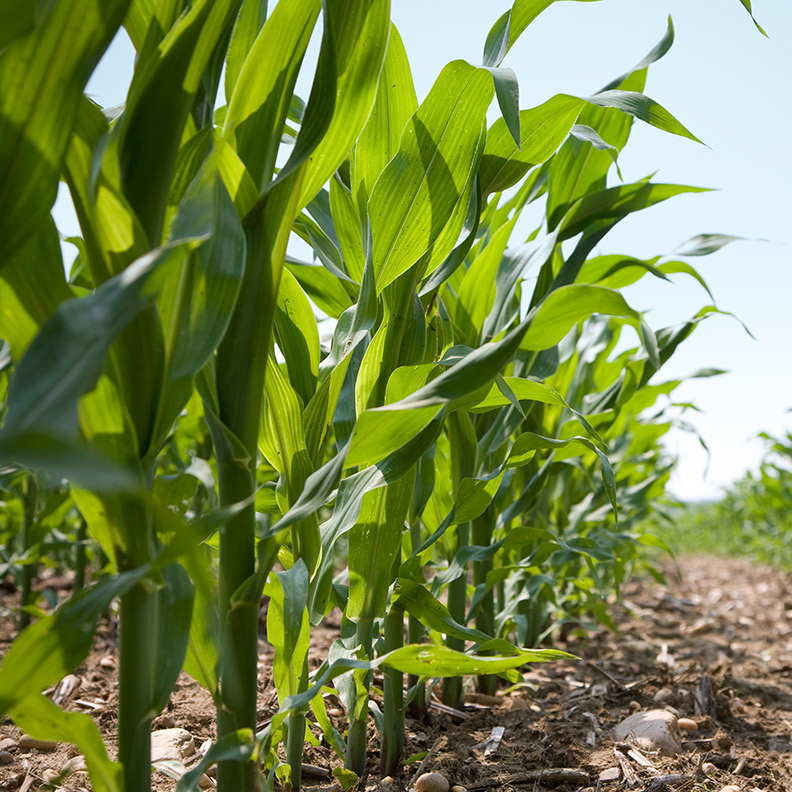The U.S. corn and soybean crops are progressing very well with 69% of corn rated good/excellent versus 57% last year and 69% of soybeans rated good/excellent versus 54% last year, according to USDA. Limited amounts of localized wind damage have been reported throughout the Corn Belt, most commonly green snap in corn, but moisture levels are ideal in many areas for crops heading into the often hot and dry month of August.
Farmers are busy scouting fields for pests and fungus now that a successful corn pollination period is nearing completion. Army worms, root worms, and aphids have all been reported in the upper Midwest in much higher numbers than in recent years. Some farmers are attributing pest and fungus issues on high amounts of precipitation throughout June and July.
U.S. row crop
China surprised U.S. commodity markets with their largest purchase of U.S. corn ever on July 14. The sale was the third largest sale in U.S. corn export history. Although the Chinese are significantly behind pace of the Phase I trade agreement, the recent purchase signals opportunity on the global market.
Both corn and soybean crops are maturing faster than historical averages. Both crops are about one to two weeks ahead, which helped conditions benefit from the high amounts of rainfall in June and July. Winter wheat harvest is also progressing well with 74% of the crop harvested, which is even with the five-year historical average pace, according to USDA.
$6.2 billion of the $16 billion Coronavirus Food Administration Program (CFAP) budget has been made in direct payments to farm producers as of July 20. Dairy producers account for $1.25 billion and livestock $3.15 billion of the payments made to date. Any farm producer who has yet to sign up for CFAP via their local Farm Service Agency office is encouraged to quickly do so. USDA recently expanded the eligible crops to include 40 more specialty crops.
An additional agriculture aid package may come prior to the upcoming federal election. The National Pork Producers Council, among other ag groups, asked Congress for additional COVID-19 aid. In swine alone, 300,000 to 400,000 hogs were euthanized in May, according to Kerns and Associates, due to limited processing capacity. Many of the livestock and dairy producers are still experiencing major price issues due to the pandemic. This week, Senate Republicans introduced an additional relief package with $20 billion allocated to USDA for CFAP, according to Agri-Pulse.
U.S. livestock and dairy
USDA decreased projected 2020 milk production by 0.5% due to slower growth in milk per cow in the latest WASDE Report. The projected 2020 all milk price was increased by 9.6% to an average $18.25 per cwt primarily due to increased commercial exports.
Dairy farmers received another USDA Dairy Margin Coverage Program (DMC) monthly trigger price in May. DMC milk margin above feed costs for March through May were $9.15, $6.03, and $5.37, respectively. Payments are possible when the milk margins are below $9.50, depending on elected coverage at the farm gate.
Livestock prices are recovering from the glut of livestock stuck in the supply chain due to decreased processing capacity since the onset of the pandemic. Even if U.S. processing picked up to full capacity, the over-supply of fed animals will remain to be the primary issue keeping nearly all livestock prices suppressed.
Ground-level insights from ag bankers
RYAN CASTLE, SOUTHEAST, MN
The weather in southeastern MN has created excellent growing conditions. As of July 21, there has not been any significant weather events such as wind or hail that caused crop damage. Calculated heat units are roughly 15 days ahead of normal and topsoil moisture is adequate. Most fields have started or are tasseled right now, and soybean fields are starting to flower. There are no signs of stress or nitrogen leaching in the area as most area rains have been gradual and less than one inch. Canned and specialty crop outlooks are also fantastic. All livestock buyers are back in the sale barns with fat cattle prices holding steady. However, feeder cattle prices are much higher than fat prices, which is causing concern for batch purchases of beef cattle.
DUSTIN GRABOWSKA, NORTHWEST, MN
It has been an interesting couple of months of weather to say the least. Since planting wrapped up in early June, we’ve experienced fairly wet conditions in northwestern MN and northeastern ND, including a two-week stretch of very warm temperatures in early July. There have been some widespread reports of hail/wind as well. If we can get a stretch of drier conditions, we anticipate some decent overall yields in our area for wheat, soybeans, sunflowers, and sugar beets. Although some spots are soggy, overall we have adequate moisture at this time. There is still a window of opportunity for the fields to dry up and the crops to recover and produce some nice yields leading up to harvest.
TAMI NESS, NORTH CENTRAL, ND
The weather pattern in north central ND has been very erratic, with some counties receiving record rainfall totals in June and July, while neighboring counties are experiencing moderate to severe drought conditions. Wheat production will drop off dramatically in the drier regions, with yields projected to be around 40-50 bushels per acre. Disease may sabotage strong wheat yield outlooks on the wetter ground. Corn is progressing nicely throughout the region and the only real downside risk is wet corn for the second straight year. Early seeded soybeans look very promising, while the soybeans that were seeded later in the spring show signs of compaction due to heavy rainfalls and high temps. Emergence issues will be the driving force behind low soybean and edible bean yields. The financial damages inflicted by COVID will undoubtedly continue to have a dramatic effect on our producers.
Global ag
The monstrous $2.44 billion Brazilian railroad project is getting closer to reality. The project is one approval away from going out to contractor bids. The railroad will connect the critical state of Mato Grosso to the Amazon port city Miritituba where both Cargill and Bunge have port presence. Currently, the only transportation solution for soybeans and corn to migrate from Mato Grosso to the Amazon is almost completely limited to one road: BR-163. Rail will provide Brazil’s top growing soybean state with cheaper freight outbound, but also cheaper freight in bound for farm inputs and fuel. When completed, this will increase Brazilian crop margins even further.
Brazilian exports set records in the first half of 2020, but now that soybean stocks are dwindling before the new crop is available, U.S. soybean exports should see higher market share.
African Swine Flu is still decreasing Chinese pork production. China has experienced seven straight quarters of decreased pork production. There is currently no treatment available for infected pigs.
What to watch for
The weather will dominate the agriculture news moving forward into harvest. Corn and soybeans have critical growth to do before reaching full maturity and fluctuations in temperatures and rainfall may cause market volatility. Crop tours highlighted by third-party yield estimates will commence in August.
Farmers should think about pricing some of their 2021 crop inputs. The price of farm fuel and fertilizers are still relatively low. Conversely, the amount of LP farmers will require for drying the 2020 crop is likely low because the crop is ahead of maturity schedule.
The Chinese purchases of U.S. ag commodities was promising in July, but we would like to see the purchases continue to gain strength throughout the rest of 2020. If political unrest continues to increase between the U.S. and China, expect significant market reaction.
Ethanol plants are slowly increasing production and profits turned positive due to decreasing stocks and improving prices. Local corn price basis should improve if ethanol production continues to ramp up.

